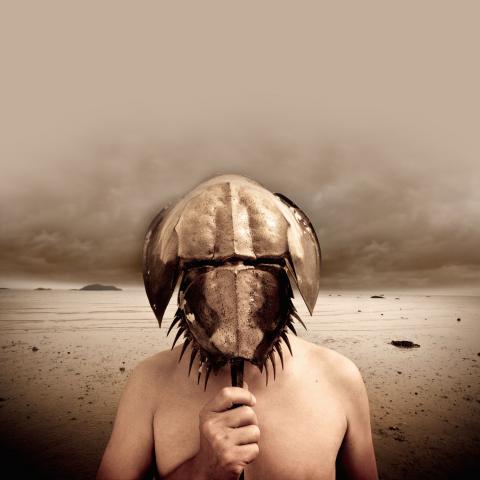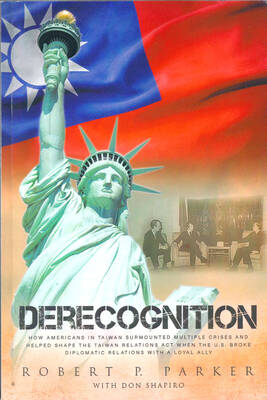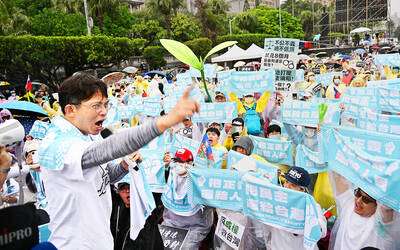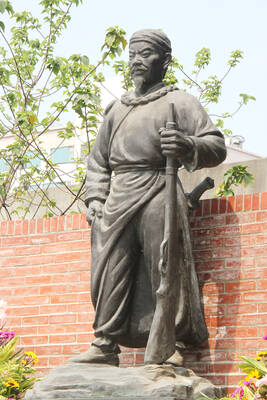The horseshoe crab, a marine species that has lived on earth for more than 200 million years , made its first documented appearance in Chinese literature in The Classic of Mountains and Seas (山海經), a compilation of Chinese mythology and largely fanciful geographical and cultural accounts of ancient China that dates back to 400 BC.
However, few people know that these living fossils once thrived on the outlying island of Kinmen — a fact that Hung Chun-hsiu (洪淳修) seeks to change with his award-winning documentary The Lost Sea (刪海經). Intelligently crafted and emotionally engaging, the documentary is commendable in its ability to go beyond environmental and conservation issues, employing the dramatic life-and-death struggle of the ancient creature as a potent symbol of the island’s turbulent past and present.
The story begins in Kinmen’s Houfeng Harbor (後豐港), where residents have relied on the sea for their livelihood since it was first settled in the Ming Dynasty.

Photo courtesy of Hung Chun-hsiu
During the Marital Law era, Kinmen was brought under tight military control. Beaches were lined with mines and punctuated with razor wire to protect it from being stormed by the People’s Liberation Army. The beachhead had the unintended consequence of keeping the area deserted, thus enabling the horseshoe crab to thrive.
Decades later, a thaw in tensions between Taiwan and China brings with it the promise of tourist dollars. In 1996, the Kinmen government launched construction of the Shuitou Commercial Port ( 水頭商港) in Houfeng in the hope of wooing Taiwan’s former enemies. Fast forward 10 years and the project, as well as the money it is meant to bring into the local economy, has yet to materialize. Meanwhile, the construction of the port has destroyed fishing grounds and devastated the ecosystem. The horseshoe crab population has disappeared along with the traditional way of life for the island’s fishermen.
Adopting a first-person narration, the documentary has a sense of immediacy that inspires empathy. Invited by Hong Teh-sun (洪德舜), a Houfeng native and self-taught marine ecologist, to make a documentary about the disappearing horseshoe crabs, Hung has evidently established friendships with the residents during the several years it took to film the documentary. He also paints an idyllic picture of a small fishing village through the stories of elderly fishermen such as Hong Mu-chu (洪木櫸) and Hong Kuang-chao (洪光照).
Through their daily routines, we learn about their sustainable fishing methods. The Hongs inform us that the horseshoe crab is an integral part of their daily life. The flesh of some are eaten, while the hard shells of others are used to make organic compost or fashioned into decorative amulets that are hung over doors to ward off evil spirits.
The juxtaposition of the failed construction project and simple life of the fishermen, is a sober and biting reminder of how runaway construction projects overseen by inept officials can destroy the environment.
Government officials are interviewed and conservation plans for horseshoe crabs are revealed. The latter involves transporting them in buckets to a newly designated habitat which, according to Hong Teh-sun’s study, is too hostile for hatchlings to survive.
The bureaucratic absurdity reaches its zenith when the Kinmen government fills in the shallow bay and leases the reclaimed land to developers, after it learns that the project proves technically unfeasible.
The most poignant commentary in the documentary comes from the horseshoe crabs themselves. In a recurring sequence, a pair of the ancient creatures are seen crawling on the seashore toward a television set playing edited newsreel footage juxtaposing images of Chiang Kai-shek (蔣介石) making calls for citizens to recover China with that of Ma Ying-jeou (馬英九) happily celebrating the opening of the “three links” — direct transportation, communications and trade links between Taiwan and China. They bear witness to the country’s history and now face demise as a new chapter begins.
The story ends in 2012. Now covered in mud, the village’s once rich seashore is unable to sustain life. Even many fishermen have left some; those who remain, like Hong Mu-chu, have found a job at a construction site. As the director comments toward the end of the film, life without the sea has only just begun.
An island-wide tour of The Lost Sea starts on Sunday, with a single screening at each venue. Sunday’s screening takes place in Kinmen’s Houfeng Harbor at 7pm, followed by an afternoon showing at Taipei’s Spot Huashan Cinema (光點華山電影館) on June 28. Other venues include the Image Museum of Hsinchu City (新竹市影像博物館) on July 5 and the Kaohsiung Film Archive (高雄市電影館) on July 12.
All screenings are free — except for the one at Spot Huashan Cinema, which costs NT$100 — and are followed by a question-and-answer session with the director. More information can be found at: thelostseatw.blogspot.tw and the film’s Facebook page at www.facebook.com/thelostsea.

One of the biggest sore spots in Taiwan’s historical friendship with the US came in 1979 when US president Jimmy Carter broke off formal diplomatic relations with Taiwan’s Republic of China (ROC) government so that the US could establish relations with the People’s Republic of China (PRC). Taiwan’s derecognition came purely at China’s insistence, and the US took the deal. Retired American diplomat John Tkacik, who for almost decade surrounding that schism, from 1974 to 1982, worked in embassies in Taipei and Beijing and at the Taiwan Desk in Washington DC, recently argued in the Taipei Times that “President Carter’s derecognition

This year will go down in the history books. Taiwan faces enormous turmoil and uncertainty in the coming months. Which political parties are in a good position to handle big changes? All of the main parties are beset with challenges. Taking stock, this column examined the Taiwan People’s Party (TPP) (“Huang Kuo-chang’s choking the life out of the TPP,” May 28, page 12), the Democratic Progressive Party (DPP) (“Challenges amid choppy waters for the DPP,” June 14, page 12) and the Chinese Nationalist Party (KMT) (“KMT struggles to seize opportunities as ‘interesting times’ loom,” June 20, page 11). Times like these can

JUNE 30 to JULY 6 After being routed by the Japanese in the bloody battle of Baguashan (八卦山), Hsu Hsiang (徐驤) and a handful of surviving Hakka fighters sped toward Tainan. There, he would meet with Liu Yung-fu (劉永福), leader of the Black Flag Army who had assumed control of the resisting Republic of Formosa after its president and vice-president fled to China. Hsu, who had been fighting non-stop for over two months from Taoyuan to Changhua, was reportedly injured and exhausted. As the story goes, Liu advised that Hsu take shelter in China to recover and regroup, but Hsu steadfastly

You can tell a lot about a generation from the contents of their cool box: nowadays the barbecue ice bucket is likely to be filled with hard seltzers, non-alcoholic beers and fluorescent BuzzBallz — a particular favorite among Gen Z. Two decades ago, it was WKD, Bacardi Breezers and the odd Smirnoff Ice bobbing in a puddle of melted ice. And while nostalgia may have brought back some alcopops, the new wave of ready-to-drink (RTD) options look and taste noticeably different. It is not just the drinks that have changed, but drinking habits too, driven in part by more health-conscious consumers and